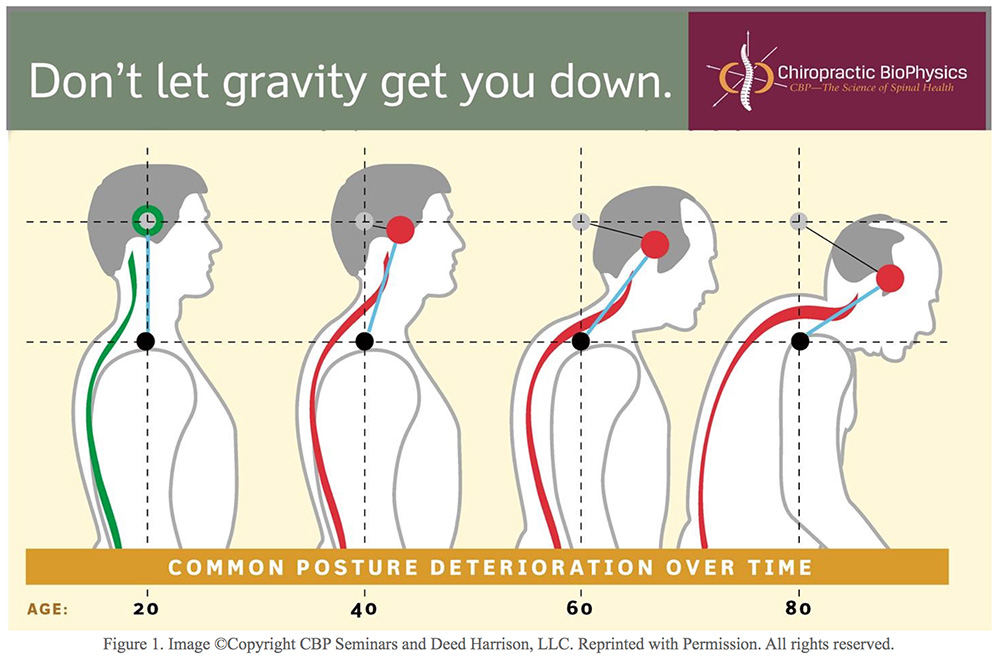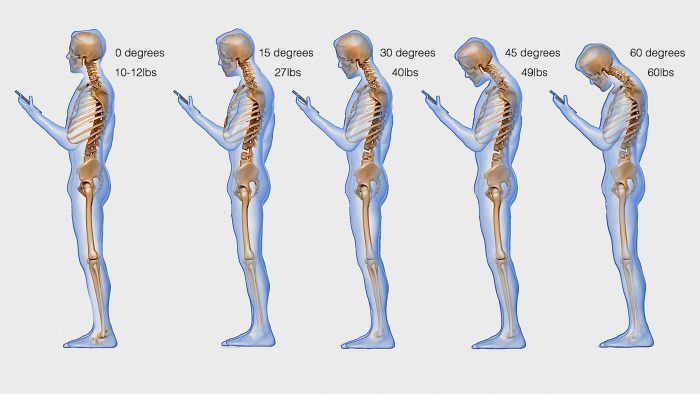Have you ever looked at your posture while texting or using your cell phone? Chances are you haven’t. However, you can spot it easily in other people; their head is jutted forward and shoulders hunched over in a stooped posture. It is easy to get caught in that posture for minutes to hours as you are focused and engrossed in your phone. Repetitive and long-term exposure to this posture is leading to a growing epidemic called “text neck”, also known as Forward Head Posture (FHP). This condition affects both young and old and has been linked to our increasing use and reliance on technology, specifically the smartphone, computer, and tablet. Ninety-five percent of Americans own or use a cell phone and use their phone for five hours per day on average.1,2 That’s three hundred minutes per day spent looking down at a phone or device. With social media, messaging apps, and live updates you are constantly being pulled to your phone. While there are positives to this surge in technology, one growing concern is how it affects your immediate and long-term health. If you have text neck, you are unknowingly putting your health at risk.
Definition of Text Neck:
Overuse syndrome involving the head, neck, and shoulders, usually resulting from excessive strain on the spine from looking in a forward and downward position at any handheld mobile device, i.e., mobile phone, video game unit, computer, mp3 player, e-reader.3
Acute Symptoms of Text Neck4
Neck pain
Middle and Upper back pain
Shoulder pain
Headaches – tension and migraine
Carpal Tunnel
TMJ and jaw pain
Long Term Effects of Text Neck4
Osteoarthritis and spinal degeneration
Reduced lung volume and asthma
Constipation and digestive issues
Fibromyalgia and chronic fatigue
Weakened Immune system
Mood imbalance
“Hyperkyphosis may be independently associated with an increased risk for adverse health outcomes, including impaired pulmonary function, decreased physical function capabilities, and future fractures” (Kado et al., 2007, p. 330)5
Text neck affects the young and the aging and is most alarming in our youth. A study in The Spine Journal showed that young people are reporting disc hernias and alignment complications due to prolonged smartphone use.6 Symptoms of text neck are disregarded as common ailments or simply addressed with over-the-counter and prescription medication disguising you from the true cause of your health problem.
Detecting text neck can be done through x-ray analysis or a simple posture check. Musculoskeletal findings are considered part of the Upper Cross Syndrome and can be detected externally, while spinal alignment can be used to detect internal factors.
Upper Cross Syndrome
Defined as having a tight upper back and neck (upper trapezius and levator scapula) along with tightened chest (pectoral muscles), countered by weakness in the middle back (rhomboids and serratus anterior) and weakness in the front neck muscles (neck flexors).

Spinal Analysis and Affects
Spinal influence can be analyzed through x-rays. “X-rays reveal how young people’s spines are changing because of chronic smartphone use, researcher Todd Lanman, a spinal neurosurgeon at Cedars-Sinai Medical Center in Los Angeles, says. “In an X-ray, the neck typically curves backward, and what we’re seeing is that the curve is being reversed as people look down at their phones for hours each day.7 The overwhelming majority of our youth rely on texting as their preferred form of communication. This leads to hours spent in poor posture every day.
Proper biomechanics of your spinal column is essential for preventing text neck. Your neck should have a backward, or cervical lordosis (a C-shaped curve in your neck with your head back over your shoulders), measured around forty-five degrees, which is considered ideal. Your upper back should round forward called a kyphosis, measured around thirty-five degrees. With text neck posture the thoracic kyphosis increases, meaning there is more rounding of your shoulders and a hunched back, and the cervical lordosis decreases, meaning your neck straightens. This puts abnormal strain on the muscles and spinal cord.
The weight of your head is approximately 10 to 12 pounds. This force is exerted through the muscles of the neck and upper back and cushioned by the spinal column. In Text Neck posture: with each inch forward your head moves off your shoulders, it adds an additional ten pounds of pressure on the spine.4 So, if your neck is a mere three inches forward in front of your shoulders, you are exerting 42 pounds of pressure on the spine. Have you ever tried holding forty-two pounds versus ten? Big difference.

Solutions
- Put down the phone
Reduce the amount of time you spend on your phone and electronic devices. Setting time limitations is helpful not only for children but for adults as well. Hold your phone more upright to avoid looking down for extended periods of time. Use a hands-free device or voice-controlled messaging app. Look down with your eyes and consciously sit with your head back over your shoulders as you text.
- Sit up straight
Remember your mother telling you to “sit up straight and don’t slouch!” Well, she was right! Make a conscious effort to catch your poor posture habits and work on correcting them. Stand up straight with your head back over your shoulders. Round your shoulders backward and take a deep breath in. Mimicking this posture, while standing on a whole-body vibration plate, can very beneficial. Whole Body Vibration stimulates proprioceptors and mechanoreceptors throughout your body. This helps re-train your brain and muscles to hold the proper posture subconsciously.
- Stretch and Strengthen
Reverse Upper Cross Syndrome by stretching and strengthening the appropriate muscle groups. Seek out a professional to help you, a Physical Therapist or Certified Trainer is a good person to call up. A simple, yet very effective, exercise is the “chin to wall push”. While sitting or standing with your back up against a wall, tuck your chin in while pushing back with your head. Think of giving yourself a double chin and you will understand the motion. Hold for ten seconds and then relax. Repeat three times, three times per week. A good time to do this is in your car while waiting for a red light, try it at let me know how you feel after a couple of weeks!
- Chiropractic is for all ages
Doctors of Chiropractic specialize in spinal health and well-being and are experts at detecting and correcting forward head posture. Chiropractic is safe and effective for all ages. Start by getting you and your family checked with a thorough examination and spinal x-rays, if necessary. Consistent chiropractic treatments can help reverse and maintain proper spinal structure.
Text neck may look funny on the outside, but the internal effects can be devastating and long-lasting. Do not wait until you have serious symptoms from this condition. Research has shown that older men and women with a hyperkyphotic posture in their mid to upper back had higher mortality rates.8 This and other studies show that having good posture is a critical factor to living a long and high-quality life.
So listen to your mother, sit up straight, and don’t slouch!
References
-
Pew Research Center: http://www.pewinternet.org/fact-sheet/mobile/
-
https://techcrunch.com/2017/03/03/u-s-consumers-now-spend-5-hours-per-day-on-mobile-devices/
-
Text Neck Institute. Dr Dean Fishman http://www.pewinternet.org/fact-sheet/mobile/
-
Effects of forward head posture on forced vital capacity and respiratory muscles activity https://www.ncbi.nlm.nih.gov/pmc/articles/PMC4755989/
Hard to Be Happy with Forward Head Posture? Dr Josh Axe https://draxe.com/forward-head-posture/
http://cbpnonprofit.com/2016/05/23/anterior-and-vertical-translations-of-the-cervical-spine-increase-stresses-up-to-4-25-times-likely-accelerating-the-development-of-spinal-arthritis-and-disc-disease/ -
Kado et al., 2007, p. 330 https://www.ncbi.nlm.nih.gov/pmc/articles/PMC2711520/
-
https://www.reuters.com/article/us-health-neck-smartphone-use/leaning-forward-during-phone-use-may-cause-text-neck-idUSKBN17G12Z
-
http://naturalsociety.com/text-neck-young-people-spine-issues-1837/#ixzz50UPnSWYU
-
Kapandji, Physiology of Joints, Vol. 3 http://pmj.bmj.com/content/51/599/682.2


